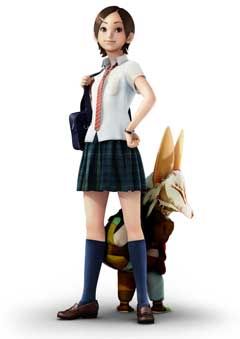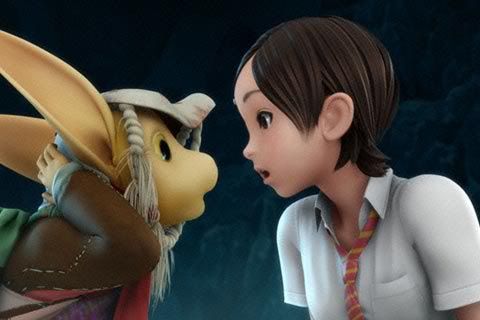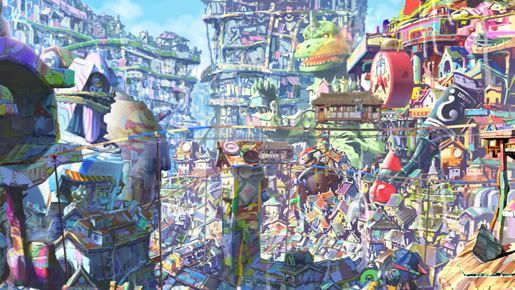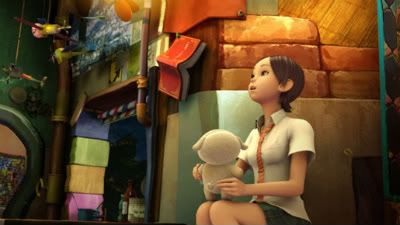An Exclusive Look at “Oblivion Island”
 What ever happened to all those old toys and doodads you had when you were a kid? Doesn’t it feel like they have just simply vanished off of the face of the Earth?
What ever happened to all those old toys and doodads you had when you were a kid? Doesn’t it feel like they have just simply vanished off of the face of the Earth?
That is the premise behind the latest anime movie from Production I.G., Oblivion Island: Haruka and the Magic Mirror. As a child, Haruka heard an old Japanese fable of how all the items that have gone unnoticed and forgotten by people eventually get picked up and taken away by nature’s most sneaky creatures, foxes.
Now your typical rebellious teenager, Haruka wonders what ever happened to a mirror given to her by her late mother. She happens upon a Shinto shrine and makes an offering to the gods to return the mirror to her. There she encounters a tiny fox-looking creature named Teo carrying an abandoned toy plane.
While following him, she is suddenly swept away to Oblivion Island, a secret world inhabited by Teo’s people and built entirely out of the objects that humans have long forgotten about. So now she teams up with Teo to explore the island and find her long lost mirror.
The movie was only released in Japanese theaters a few months ago, but Fuji Television was generous enough to invite me to an exclusive screening in New York City last week. What I saw was an absolutely delightful children’s film filled with more imagination, heart, and wonderment than the last two Miyazaki films combined.

Oblivion Island is the first full length film from Production I.G. done completely in 3D computer generated animation. The film’s animation director, Naoyoshi Shiotani, was on hand at the New York screening to offer his take on the making of the studio’s landmark title.
“I was moved to finally see the finished cut,” he tells a sold out theater audience. “There were 200 people involved in this movie and I spent 4 years working with them on it. I put a lot of my thoughts and feelings into this movie.”
While almost every animated film in America is done in 3DCG these days, we very rarely see it done in Japanese anime. However, the difference between Hollywood and Japanese cinema is still evident in this particular medium.
The character designs have that unique “anime” style to them, and the look and feel of the animation resembles more like a video game cut scene than a Pixar or Dreamworks film. This is a little difficult to get used to as a viewer. Human characters like Haruka and her parents give off the look of plastic, lifeless dolls, and their body movements are stiff and unnatural.
But the awkwardness of the CG animation completely fades away the moment that Haruka and Teo go to Oblivion Island. The fictional world is so beautifully rendered with vivid bright colors, and incredible detail has been paid to the buildings comprised completely of old signs and cardboard boxes.

“I wanted this movie colorful,” explains Mr. Shiotani, “because the island is created with things people leave behind. I think there must be a variety of things like that, so that is why I wanted to make the island as colorful as possible.”
But even more impressive than the visuals is the emotional story of how teenage Haruka reconnects with her own childhood by wondering around the island. The turning point comes when she stumbles upon Cotton, her adorable long-forgotten stuffed animal.
 “Stuffed animals are usually loved and hugged by people, which means they should be cute or lovable. Cotton was once loved by Haruka. So, I wanted something very cute and pretty that the audience would fall in love with instantly.”
“Stuffed animals are usually loved and hugged by people, which means they should be cute or lovable. Cotton was once loved by Haruka. So, I wanted something very cute and pretty that the audience would fall in love with instantly.”
And we do. Cotton’s reunion with Haruka brings about the same kind of emotional identification and response we had to the “When She Loved Me” flashback montage in Toy Story 2. But unlike Toy Story, Haruka and her cherished doll are able to speak to each other in this magical island, thereby putting into words the type of love that is otherwise implied between a child and their toys.
Needless to say, I fell head over heels for this film, and being a blog about Japanese anime in America, I have to look at how such a film would do in our domestic market.
Unfortunately, the problem that Oblivion Island faces is that it is an anime film made for children. It is a fantastic children’s film, but that would still be a tough sell for the predominately mature American market. In fact, I think the only way you can release a children’s anime film domestically is to attach the name “Miyazaki” to the credits.
And that is a real shame. When I gave Miyazaki’s Ponyo a negative review earlier this summer, the biggest reaction I heard back from the community was, “well, that’s because it’s made for kids, so of course you wouldn’t like it.” But being a children’s film doesn’t mean it has to be a bad film. With its childish blend of fantasy and Japanese traditions, Oblivion Island has shown me just what Miyazaki has been missing since Spirited Away.

This movie is too good to be kept hidden in Japan forever. The New York International Children’s Film Festival takes place every year in the city, and it has been the home to many great anime films in the past. I believe that Oblivion Island is perfect for this festival, and I hope that one party approaches the other to get this movie playing there next year.
Oblivion Island is the best anime film I’ve seen in a long time, and I hope more American fans have the chance to see this heartwarming and delightful 3D story too.
Movie screening and animation director comments courtesy of Fujisankei Communications International and IACE Travel. All images ©2009 FUJI TELEVISION NETWORK/ Production I.G. / DENTSU / PONY CANYON